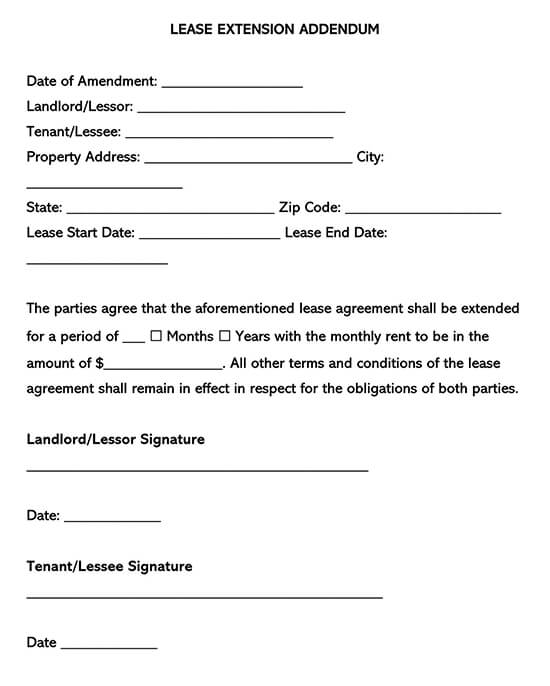A lease extension is a formal agreement between two parties, who are typically landlords and tenants, to extend the conditions and terms of a pre-existing lease agreement.
Generally, such agreements happen when a lease term expires, but the tenant(s) and the landlord(s) would like to maintain the same conditions and simply extend the term of the lease. In simpler terms, it works as a continuation of an existing lease agreement on expiration. The extension allows for a reworking of certain details, such as the monetary amount that is paid as rent, as well as improvements and modifications that may be made. That being said, they generally maintain the same conditions, allowing landlords and tenant(s) to keep the same lease for an additional period of time.
Keep in mind that a lease extension differs from a lease renewal. A renewal typically indicates that a new lease agreement is drawn up, binding the parties to potentially new terms and conditions. An extension simply continues the previous agreement with certain sections being revised, if necessary.
Free Template

When is a Lease Extension Necessary?
Apart from the obvious situation when lease agreements expire, there are a number of situations that require the extension instead of a lease renewal. These are, of course, situational and usually require an agreement to be reached between the landlords and the tenant(s).
Common situations include:
- In the case that a tenant(s) have upheld their end of the agreement, including maintaining the place in a satisfactory manner, paid rent on time, and has generally nurtured a good relationship with their landlord, the landlord might want to avoid additional paperwork, bureaucracy, and administrative formalities. Instead, simple revisions can be added to make the process less of a hassle for both the tenant(s) and the landlord.
- Sometimes, the tenant(s) may require a shorter lease. This typically occurs when they are in the process of moving or finding a new property, but may need to extend their existing lease for a shorter period of time, such as a few months. In this case, upon landlord approval, they may sign the extension for a period that is much more suited to them, instead of signing a year-long extension. These can be monthly extensions, but generally depend on the particulars of the situation and require the landlord and the tenant(s) to reach an agreement and sign an extension based on those terms.
- Keep in mind that without the extension, the tenant(s) enter somewhat of an unpredictable situation. Without the extension, the tenant(s) that make an agreement with the landlord to stay on a month-to-month basis become what is known as a “holdover” tenant. This puts them at the mercy of the landlord, as he can choose to evict them when he desires. As a result, it gives little legal protection to the tenant(s), which is why the extension may be necessary, as well as convenient for short term extensions.
Drafting a Lease Extension Addendum
This addendum will require the following details:
- Names of the tenant(s) and the landlord with a referral to the original rental agreement (with the date as well.)
- Address of the domicile, as well as the date on which the addendum is signed by both parties and added to the original rental agreement.
- The timeline of the extension – This typically refers to the date from which the extension is to start, to the last day. This will need to be discussed prior to signing the addendum.
- Contingent conditions to breaking the lease prior to the end date will also need to be discussed. Normally, the tenant(s) will be required to pay an extra amount, typically equivalent to the amount remaining on their lease to break it. They may also speak with the landlord to see if he or she would accept another tenant in their stead. In such cases, the onus of finding a replacement tenant falls on the tenant who intends on breaking the lease. The terms of such situations must be detailed explicitly in the addendum.
- The amount that is paid as rent must be explicitly stated in the addendum. In some cases, a deposit may be required as security. This must also be explicitly put down in the addendum.
- The care of the domicile during the rental period must be explicitly outlined. This includes clauses like the modifications and improvements clause and generally outlines the steps the tenant(s) must take in order to maintain the residence.
- Finally, all parties subject to the agreement must sign at the end of the addendum, along with the date.
Frequently Asked Questions
As we mentioned earlier, the extension typically revises certain particulars of the contract, but, generally, uses a previous lease agreement and extends it. This allows landlords and tenants to bypass any administrative formalities or bureaucratic needs, making for a hassle-free process. A renewal, on the other hand, is a totally new lease that will require the signatures of both parties. This needs to be registered again with the authorities and can be a longer, more drawn-out process.
Some tenants may need to stay for an additional period after their lease expires. These are legally referred to as “holdover” tenants, who may, upon agreement with their landlord, stay on a month-to-month basis without any legal documentation. This, however, affords them very little legal protection, as they may be forced to evict when the landlord desires. For these reasons, tenants are advised to sign the extensions even for short term extensions.
In some cases, tenants may need to stay in the domicile for an unknown period of time or extend their stay for just a few months. In such cases, they can also sign a month-to-month rental agreement. These typically do not establish a start or end date. Instead, they require the landlord or the tenant to provide one month’s notification in advance when they decide to vacate the premises/evict the tenant. Essentially, such an agreement allows both parties to terminate the agreement on a monthly basis.












